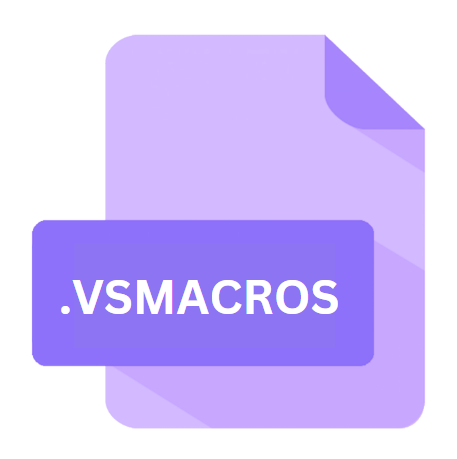.VSMACROS File Extension

Visual Studio Binary Macro Project
| Developer | Microsoft |
| Popularity | |
| Category | Developer Files |
| Format | .VSMACROS |
| Cross Platform | Update Soon |
What is an VSMACROS file?
The .VSMACROS file extension is primarily associated with Visual Studio, one of the most popular integrated development environments (IDEs) used by software developers worldwide.
These files contain macros, which are sequences of commands and instructions that automate repetitive tasks within the Visual Studio environment.
Macros enable developers to streamline their workflows, enhance productivity, and maintain consistency in their coding practices.
More Information.
The introduction of .VSMACROS files marked a significant advancement in the capabilities of Visual Studio.
By storing macros in a binary format, Microsoft aimed to improve performance and ensure compatibility across different versions of the IDE.
This allowed developers to create complex macros with ease, leveraging the full power of Visual Studio’s extensibility framework.
Initially, .VSMACROS files were primarily used for automating repetitive tasks such as code generation, refactoring, and debugging.
Developers could record their actions within Visual Studio and save them as macros for later use. Over time, the scope of macros expanded to encompass a wide range of activities, including project management, version control, and integration with external tools.
Origin Of This File.
The origins of .VSMACROS files can be traced back to the early versions of Visual Studio. As developers sought ways to automate common tasks and optimize their coding processes, Microsoft introduced the concept of macros as a solution.
Initially, macros were stored in plain text files with the .MACRO extension. However, with the evolution of Visual Studio, the format transitioned to a binary representation, resulting in the .VSMACROS file extension.
File Structure Technical Specification.
The .VSMACROS file format is binary-encoded, meaning that its contents are not human-readable without specialized tools.
The structure of a .VSMACROS file typically consists of metadata followed by the actual macro code. The metadata section contains information about the macro, such as its name, description, and author.
The macro code itself is stored in a binary format optimized for execution within the Visual Studio environment.
While the specific details of the .VSMACROS file format are proprietary to Microsoft, developers can interact with macros using Visual Studio’s built-in macro editor or through automation interfaces such as the Visual Studio Extensibility (VSX) API. This allows for the creation, editing, and execution of macros directly within the IDE.
How to Convert the File?
Converting .VSMACROS files to other formats or platforms may be necessary to address compatibility issues or leverage alternative development environments.
While direct conversion methods are limited due to the proprietary nature of Visual Studio macros, developers can explore the following approaches:
- Manual Recreation: Recreate the desired automation logic using platform-agnostic scripting languages or IDE-agnostic tools.
- Custom Tooling: Develop custom utilities or scripts to parse .VSMACROS files and generate equivalent automation scripts compatible with other IDEs or tools.
- Third-Party Solutions: Explore third-party tools or plugins designed to import and execute Visual Studio macros within alternative IDEs or development environments.
Advantages And Disadvantages.
Advantages:
- Productivity Enhancement: By automating repetitive tasks, developers can focus more on high-level design and critical problem-solving.
- Consistency: Macros ensure uniformity in coding standards and practices across projects and team members.
- Time Savings: Automation reduces the time required for mundane tasks, increasing overall efficiency and throughput.
Disadvantages:
- Compatibility Issues: Visual Studio macros are tied to specific versions of the IDE, limiting their portability across different environments.
- Security Concerns: Malicious macros can pose security risks, potentially compromising the integrity of development environments.
- Maintenance Overhead: As projects evolve and IDE versions change, macros may require updates and maintenance to remain functional.
How to Open VSMACROS?
Open In Windows
- .VSMACROS files can be opened directly in Microsoft Visual Studio, the primary IDE for Windows development.
- Simply double-click the .VSMACROS file, and it will automatically launch and execute within Visual Studio.
- Alternatively, you can open Visual Studio and import the .VSMACROS file through the IDE’s menu options.
Open In Linux
- While Microsoft Visual Studio is not natively supported on Linux, developers can explore alternative IDEs like Visual Studio Code (VS Code).
- Install the Mono framework, which provides a compatible runtime environment for some .NET applications on Linux.
- Utilize MonoDevelop, an open-source IDE with cross-platform support, to open and execute .VSMACROS files.
Open In MAC
- Similar to Linux, macOS does not support Microsoft Visual Studio directly.
- Consider using Visual Studio Code, which offers robust support for various programming languages and extensions.
- Install Mono or MonoDevelop on macOS to run .VSMACROS files, leveraging compatibility with .NET-based applications.
Open In Android
- Android is primarily a mobile operating system and is not suitable for executing .VSMACROS files directly.
- Developers can remotely access Windows-based development environments through remote desktop applications or virtualization solutions.
- Install remote desktop software on Android devices and connect to a Windows machine with Microsoft Visual Studio installed to access and execute .VSMACROS files.
Open In IOS
- iOS is also a mobile operating system and lacks native support for .VSMACROS files.
- Developers can follow a similar approach as with Android, utilizing remote desktop applications to connect to Windows-based development environments.
- Install a remote desktop client on iOS devices and establish a connection to a Windows machine with Microsoft Visual Studio for accessing and executing .VSMACROS files.
Open in Others
- For other operating systems not mentioned above, such as FreeBSD or Chrome OS, compatibility with .VSMACROS files may be limited.
- Consider using cross-platform IDEs like Visual Studio Code or MonoDevelop, which offer broader support across diverse environments.
- Alternatively, explore virtualization solutions or cloud-based development environments to run Microsoft Visual Studio on supported platforms.













